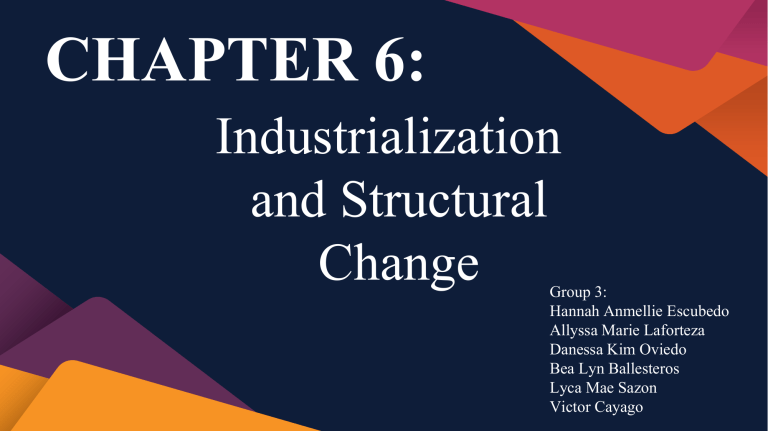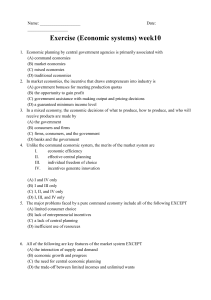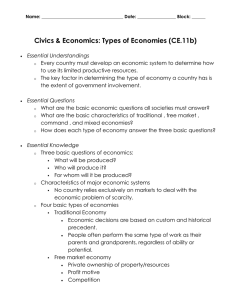
CHAPTER 6: Industrialization and Structural Change Group 3: Hannah Anmellie Escubedo Allyssa Marie Laforteza Danessa Kim Oviedo Bea Lyn Ballesteros Lyca Mae Sazon Victor Cayago 6.1 Introduction: Industry as a Leading Sector INDUSTRIALIZATION- the process by which an economy is transformed from primarily agricultural to one based on the manufacturing of goods. Individual manual labor is often replaced by mechanized mass production, and craftsmen are replaced by assembly lines. Characteristics of Industrialization include economic growth, more efficient division of labor, and the use of technological innovation to solve problems as opposed to dependency on conditions outside human control. STRUCTURAL CHANGE- refers to dramatic shift in the way a country, industry, or market operates, usually brought on by major economic developments. The key to effect structural change is the dynamism that is inherent in that system. 6.2 A Model Structural Change Lewis-Fei-Ranis- a dualism model in developmental economics or welfare economic. It is also know as the surplus labor model. Two sector of the model °Traditional and Modern °Agricultural and Industrial, or Rural and Urban 6.2.1 What are the Features of this Model? °Capital Accumulation °Labour Supply °Integration to the World Economy 6.2.2 Introduction of Trade into the LFR Model When introducing the possibilities of trade, the model becomes more complex but the basic features remain. 6.3 Backward and Forward Linkages The interaction between the industrial and rural sectors can be studied using the concept of backward and forward linkages. 6.3.1 Indirect Backward Linkages Secondary effects which growth in an industry has on its suppliers. Industries that have strong backward linkages have low value-added and a large input from local suppliers. 6.3.2 Forward Linkages It tell us how a product is related as an input into the production of a product at the next stage-- textiles into apparel, for example, petroleum into plastics. Forward Linkages are a good indication of the extent to which an economy can upgrade its industrial base by using its existing expertise and resource base. 6.4 Aspects of Industrial Development • Choice of Technology • Economies of Scale 6.4.1 Choice of Technology • In the early stages of industrialization, countries have limited capital and plentiful labor • Labor-intensive technologies may be appropriate in a poor country with plenty of low-skilled and cheap labor but because of factor market distortions, the choice of technology may be more capital-intensive. 6.4.2 Economies of Scale - a proportionate saving in cost gained by an increased level of production. • Economies of scale come into play when a country is exporting, or when production is taking place on a large of scale for the domestic market • The standard for measuring the efficiency of an industry is to use the price of imports. 6.5 EFFICIENCY ISSUES 6.5.1 Economic Efficiency and Scale of Production • Efficiency depends upon a number of special factors. • It may be that all firms can be efficient if they have reached a viable size of production that takes full advantage of economies of scale • Better transport and communication also make it possible to have a nationwide production, marketing and distribution strategy. 6.5.2 Do Protected Industries Become Efficient Over Time? • Evidence suggests that there are numerous pitfalls to a strategy of protecting infant industries • These industries and firms will eventually be forced to compete in external markets. • In order to become competitive, they should be in an industry where the country has a comparative advantage or else they will be inefficient 6.5.3 Are There Advantages to Small-Scale Industrial Development? • Scale-scale enterprisee (or small and medium enterprises-- SMEs) are generally more labor intensive. • Small-scale firms can be very successful when they concentrate in particular locations where they can share a skilled labor force base and where they can produce differentiated products of high quality. 6.6 Foreign Trade • Export are critical in explaining productivity gains in the asian economies. internal competition does not seem to be sufficient to bring about high rates of productivity increase. • Example, large country with low industrial concentration ratios, efficiency rates are still low. 6.7 Other Transition Issues Indonesia has not been able to make the transition because of this following reasons: 1. Indonesia still has a large oil and natural gas sector. 2. It had a late start in the industrialization. 3. It has a labor force that lacks education. 4. They dominated much of its development thinking. 6.8 The Asian Experience with Industrialization From the mid-1960s to the late 1990s, the growth rate of the East Asian economies of Hong Kong, Korea, and Taiwan, together with Singapore in Southest Asia - sometimes called the Asian "tigers", or the newly industrialized economies(NIEs) - grew at a faster rate than any other economy or group of economies had in history (World Bank, 1993; and Quibria, 2002). 6.8.1 A Further Look at Total Factor Productivity(TFP) •The reason for the rapid growth was brute force application of a simple Harrod-Domar growth model augmented by the growth of the population. •In order to sustain a rapidly growing industrial sector in a quickly evolving global environment, much more is required than just a high rate of investment and appropriate pricing of inputs and incentives for export. 6.8.2 Historical Transformation of the Industrial Sector - to give you an idea of how the structure of industries within these economies has changed over time consider a snapshot of their industrial sector in the early 1960s, 1975, and 1990. Five Components: 1. Resource - based industries that include aluminum, food, and oil refining as examples. 2. Labor - intensive industries, including garments, footwear, and toys. 3. Scale - intensive industries, including steel, automobiles, paper, and chemicals. 4. Differential industrial products, including TVs, power equipment, and advanced machinery. 5. Science - basee industries, including electronics, pharmaceuticals, and biotechnology. 6.8.3 The Electronics Sector in order to examine the structure transformation in the industrial sectors of the NIEs and to look more closely at the role of technology, it is useful to focus on the electronics industry. 6.8.4 Different Patterns of Technological Transfer - the methods varied from economy to economy There were four basic factors underpinning their success: 1. Firms benefited from low rates of interest, low inflation, and high rates of saving within the economies. 2. They all respond to the open and outward-looking export-led strategies that were generally followed. 3. All the NIEs developed an appropriate human resource development strategy that complemented and provided trained workers for the growing industrial sector. 4. Government intervention was undertaken whenever it was needed. 6.8.5 Country Experiences - hence, over the years, the Asian countries have actively developed their electronics sector although there are differences in thier field of specialization owing to differences in the labor force and technological advances.


